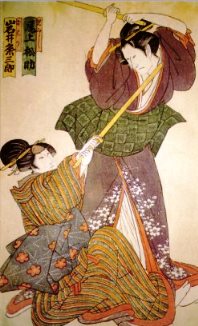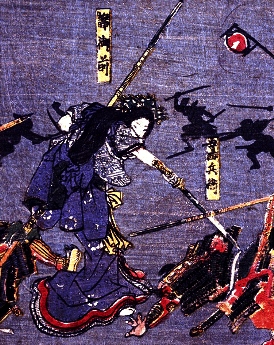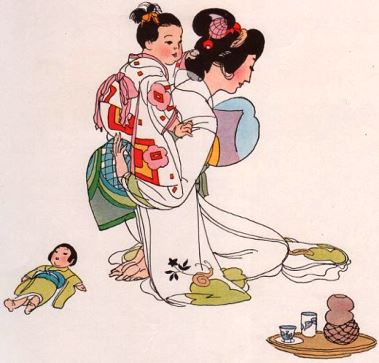| |
|
 |
In the early
feudal period, the Buke was the elite Japanese military
class. The Buke women fought fiercely to defend their homes
while their samurai husbands were at war.
It was not out of the ordinary for women to
become samurais and warriors. These women were known as the
onna-bugeisha and were expected to show: loyalty, bravery, and
take on the duty of revenge if their husband or Daimyo was
killed.
|
 |
Write the above heading on a new page in your book and
then answer the following questions in complete sentences:
1. What was known as the
Buke in Medieval feudal Japan?
2.
What was expected of the women warriors during this era in
Japan?
|
Since her
warrior husband was often absent, the samurai wife also had
important duties at home. Her responsibility was the food
and all the household supplies. She oversaw the harvesting
of crops, managed all the servants, and took over all
financial business.
In matters which
concerned the well-being of the family, her advice was
sought and her opinions respected. She also had to provide a
proper education of her children, especially through
instilling in them, a strong sense of duty, courage and
physical strength.
3. List the duties
that were expected of a Samurai wife in her home?
|

|
 |

4. Who was Hojo Masa-ko and why is she referred to
as "Mother Shogun"?
During
wartime, women sometimes had to defend their homes.
Buke
women were trained to pierce an attacker's
chest or throat with a kansashi, the long pins used primarily
to keep a woman's hair in place.
It took considerable
strength and skill for these women to battle invaders while
wearing the cumbersome double layers of silk kimono and
traditional straw sandals.
(http://www.woa.tv/articles/hi_samurai.html ) |
| |
 |
Trained in weaponry,
women also carried a dagger in their sleeves or sashes and could throw
with deadly aim. The naginata, a long, curved sword, was considered the weapon most
suitable for women. Japanese girls today continue the ancient art of
naginatajutsu as they learn how to wield the naginata.
Sometimes women
joined men in battle, actually fighting along side them or
encouraging the troops. And, like their husbands, women were
expected to commit suicide, also known as
hara-kiri, if the family
was dishonoured in any way. For this they would use a
kansashi. Some women used suicide as a form of
protest against injustice, as in the case of one woman who killed
herself when her husband mistreated her.
|

Wood-block carved print of a samurai woman in
battle. |
 |
5. What is
this object seen on the left. List three
possible uses this object could have had for
Buke women during medieval feudal Japan?
6. What is a naginata? Find a small image (painting or drawing) of a woman wearing
traditional Japanese dress and wielding
(using) a naginata, and paste it in your book.
7. For what
reasons might a Buke woman in feudal Japan
commit hara-kiri?
|
|
|
|
|
Over time the independent samurai woman was
replaced by a different image, to be humble, obedient,
self-controlled and above all subservient to men. Respecting one's
husband and family and bearing a male child became this ideal
woman's most important tasks. By the later feudal ages, the laws
changed which made it impossible for daughters to inherit property.
After the 15th century, the
Buddhist and Confucius
teachings of the "Three
Obediences" reinforced women’s lesser status in society.
"A woman has no way of independence through life. When she is young, she
obeys her father; when she is married, she obeys her husband; when
she is widowed, she obeys her son."
(Text source:Lost/unknown!)
8. How did the role of samurai women change in the later feudal
ages? How were they expected to behave and what was considered their
most important task or function?
Briefly quote from the Buddhist
and Confucius teachings in your answer.

|
 |
http://womenofhistory.blogspot.com/2007/06/women-warriors-of-japan.html
9. From the above site find out
what is a kaiken, another secret weapon
that Japanese samurai women carried.
10. From the ancient
historical account called The Tale of Heike, describe the appearance and
skills of the famous female samurai
Tomoe Gozen.
Or draw some cartoons that tell the tale of the samurai
Tomoe Gozen.
|
|
|



